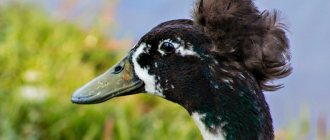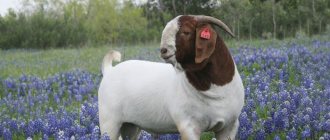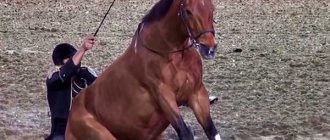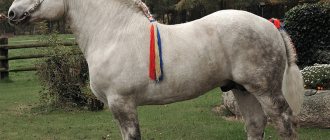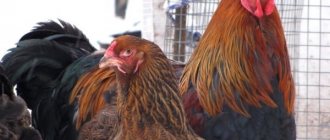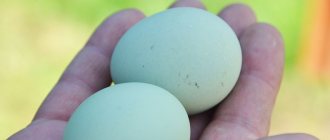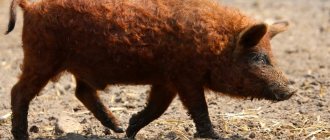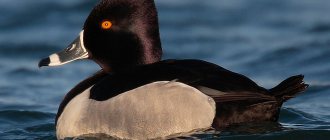Home » Articles about chickens » Russian Crested breed of chickens
One of the most successful breeds of chickens for private households is the Russian Crested. It was entered into the State Register of the Russian Federation in 1993. Birds have an excellent set of economic characteristics - they are unpretentious to living conditions, have good productivity, and rarely get sick.
Interesting historical data
The breed is considered primordially Russian, but the history of its origin is not reliably known, and still causes debate in scientific circles. According to one version, the breed came from Asia; according to another, it was bred by Russian farmers more than 100 years ago. The second is supported not only by records in the archives, but also by the bird’s ability to tolerate our climate.
Regardless of the versions of its origin, this breed is widespread in Russia and is also grown in Asia. In European countries, the number of Russian crested cats is small.
Official recognition
The description of the standard for the crested chicken breed was first declared in 1905. Chickens were classified as breeds of the meat-egg line that have a universal purpose.
Revolutionary events brought devastation among the purebred livestock, but crested laying hens continued to be raised due to their unpretentiousness to feed and maintenance.
In the USSR, they set a course for introducing a national breed from each republic. The resolution applied to all types of livestock, not just chickens. The presented Russian crested chickens received a lot of favorable reviews and were recommended for breeding by poultry farmers.
Later, unpretentious laying hens were replaced by productive hybrids, displacing the original Russian breed.
Description and characteristics of the Russian Crested breed
Let's look at the main characteristics of this breed.
Appearance of the bird
Exterior features include:
- The birds are medium in size. Their main distinguishing feature is the crest on their head, the feathers of which are directed backwards. At the same time, they can stick out or create an “artistic mess” on the head. The hairstyle is sheaf-shaped or helmet-shaped.
- The comb is red in color and leaf-shaped, but also pink-shaped and regular in shape without any shoots.
- The head itself is small, slightly elongated, proportional to the body. The face, earrings and lobes are also colored red. Breed standards allow a small amount of white inclusions.
- The color of the eyes and beak depends on the plumage. Representatives with orange eyes are more common, less often - with light yellow, brown or red. The color of the beak varies from yellow to dark gray. It is strong, slightly curved. The feathers fit tightly to the body and are directed strictly back.
- Russian crested cats have a short neck. The back is wide and level. The tail is well developed. The chest is also wide and dense. The wings are lowered, strong and strong. The legs are short and unfeathered.
Differences between a rooster and a chicken
The male and female of this breed are quite different in appearance. A rooster is much larger than a hen. Its powerful body is almost 2 times larger than that of a laying hen. But the hairstyle is much more modest. Due to its larger crest, it has a much smaller crest than that of females. But it has a mane of feathers, so it usually hangs to one side.
Laying hens have a very lush and thick crest. It needs to be trimmed from time to time to keep it from covering their eyes. The male's tail is triangular in shape. It is lush and long. Moreover, not only the braids are long, but also the cover feathers.
Color
The breed is also interesting because it has a variety of colors. The standards do not have strict restrictions on this issue, but there are 10 main colors:
- White. The most common birds are those with white coloration. These individuals have a beak and metatarsus—the leg bones located between the tibia and toes—that are yellow.
- Black. Individuals with black coloring have brown eyes, a dark gray beak and gray metatarsals.
- Red. The red hen has yellow feet, dark eyes and a light brown beak.
- Lavender. An interesting lavender or bluish color occurs when the genes responsible for color are mutated. For this reason it is quite rare.
- Gray. The gray color is characterized by feathers with a wide white border in the neck area and a narrow one on the crest. The eyes of gray representatives are brown, the beak and metatarsals are gray.
- Silver-black. The lower part of the body - the belly, sides, as well as the back and wings - are covered with black feathers, the upper part - the neck, head, crest, lower back - are silver. The eyes are brown, the beak and metatarsals are light in color.
- Golden-black. These chickens look rich thanks to the golden feathers on the neck and crest, while the rest of the feathers are black. The eyes are brown, the beak and metatarsals are dark.
- Cuckoo. These representatives are hard to miss. They have a uniformly variegated color, and their beaks and metatarsals are light.
- Calico. The most elegant and unusual color is considered to be chintz. The birds have a red or ginger base color, with feathers of lighter colors scattered throughout. It will not be possible to find two identical calico chickens, since the pattern of each individual is individual.
- Salmon. These are soft fawn chickens with black streaks on the neck and chest. The coloring resembles that of salmon.
An overview of Russian Crested chickens, as well as varieties of this breed, are presented in the video below:
However, there are several traits that are unacceptable in a breeding bird. If they are present, the birds are rejected and not used for further breeding:
- absence of a crest or its poor development;
- large comb;
- completely white lobes;
- long legs;
- the color contains yellow;
- the wings are located high;
- rough body.
Bird temperament
Birds of the Russian Crested breed are distinguished by their peaceful, friendly character. These representatives have excellent neighborly relations with other birds, become attached to the owner, are not afraid of people and are easily tamed.
However, you should not think that these are phlegmatic natures. On the contrary, they are emotional, active and loud.
Puberty and egg production
The breed is a universal species. The poultry farmer will provide himself not only with eggs, but also with delicious chicken meat. Females begin laying eggs at 5-6 months of age. Each year you can get 150-160 eggs from each.
Peak egg production occurs at one and a half years of laying hen, then it begins to decline. On average, an egg weighs 56 g. The shell is usually white or cream in color.
Hatching instinct
Russian corydalis have a strong maternal instinct, so the poultry farmer does not have problems with hatching chicks. If there is no goal to obtain offspring in large numbers, then hens cope with this task at the highest level.
They not only take care of the egg-laying eggs with special zeal, but then also look after their babies with the same care. At the same time, mass mortality of chickens is not observed.
Productivity
In terms of productivity, crested individuals have average indicators. Different sources contain different meanings. This is due to the genetic diversity of the breed.
So, a mature rooster can weigh from 2.7 to 3.5 kg. The chicken weighs less. Most sources indicate the average weight as 2.2 kg, but there is data about 1.8 kg.
Appearance
The crested breed of chickens has a proportional body with a harmoniously shaped elongated head and a cone-shaped neck. It gets its name from the lush crest or “cap” that is present on both males and females.
The skin of the head is red. The rose-shaped comb is small in size and, according to the description, resembles a leaf in shape. Due to its bright color, it is clearly visible on the head.
White speckles are visible on the red earlobes, and the bright red protruding earrings have an elongated shape. The crested breed's beak is black or yellow in color and has a strong and slightly curved base. The back is spotted. The legs are short but powerful, and there are no feathers at their base.
On the sides of the body there are large wings, the ends of which are lowered down. The tail is short and upturned.
Russian Crested
The plumage of crested chickens comes in a variety of colors. Representatives of this breed can have silver, white, black, fawn, blue, brown and even mixed colors
The average weight of mature chickens is 2.5 kg. Roosters weigh about 3-3.3 kg.
Crested chickens with calico plumage have a unique appearance: it seems as if such chickens are wearing a plaid shirt.
Advantages and disadvantages of the breed
Whether or not to raise this particular breed on the farm is up to the poultry farmer to decide. To make your choice easier, let’s look at the main advantages and disadvantages of the Russian Crested breed.
Among the advantages, experts note:
- excellent frost resistance of birds (they winter well in unheated chicken coops and in mild frost they prefer walks in the fresh air);
- high immunity to diseases;
- high adaptive abilities, take root in any region;
- stable egg production - 1 egg every 2 days;
- original appearance, variety of colors;
- high egg fertilization rate up to 90–95%;
- strong maternal instinct of hens;
- high hatchability rate;
- calm disposition;
- delicious tender meat.
Among the disadvantages, they note the pugnacity of roosters and the additional hassle of keeping chickens - they need to periodically trim their crest.
Productivity
Productivity is an indicator of the breed that is of primary interest to the breeder. Poultry belongs to a universal direction, which is designed to produce eggs and meat equally. Read about the features of the Adler breed of chickens at this link.
The main feature of the Russian crested chicken is its very high productivity, as for ordinary poultry.
The weight of representatives of the breed, depending on gender, differs significantly. The hen gains from 2 to 2.5 kg of live weight, and the cockerel - from 3 to 3.5 kg. Some males can reach a weight of 4 kg by the age of 2-2.5 years, but a significant part of it will be fat.
Egg production
The peculiarity of these chickens is that they can bear large offspring already at a fairly young age. They have high fertility and hatchability.
Egg mass
The eggs are quite large - on average 56 g. The very first ones are much smaller. Eggs reach standard size when the hen is 7-8 months old.
Conditions of detention
Although birds are unpretentious and undemanding in keeping, creating favorable living conditions is still the responsibility of the poultry farmer.
How to set up a chicken coop?
Due to the fact that corydalis are not afraid of frost, the chicken coop does not need to be insulated. But it must be built on a foundation 40-60 cm high and ventilation must be provided. If it is not possible to install it, then the room is ventilated daily. The air should not stagnate.
Perches are installed inside at a height of 30–35 cm from the floor surface. A bedding of hay or sawdust is laid on the floor. It is changed in a timely manner as it becomes dirty and damp. The poultry house should be dry and clean; the health of the birds depends on this. There must be artificial lighting; daylight hours must be maintained at least 12-14 hours.
Nests are placed on the floor away from the perches. Their optimal size is 50X50 or 50X40 cm.
If you want to make a chicken coop with your own hands, then this article may be useful.
Walking yard
Since birds are very active and inquisitive, there must be a walking yard with a canopy so that the birds can hide under it from the rain or hot sun. The area is fenced with a grid with small cells. The bottom of the mesh is dug into the ground to avoid undermining on both sides.
On the one hand, this will prevent the chickens from escaping, on the other hand, it will protect them from uninvited predator guests. In summer, chickens spend all their time outdoors. In winter, they also like to walk in the yard even in severe frosts down to -40°C.
Feeders and drinkers
Feeders and drinkers are kept outside in the summer, and brought into the chicken coop during the cold season. They are washed and disinfected regularly to prevent the development of pathogenic microorganisms. How to make your own feeder is written here.
The water in the drinking bowls is changed regularly. Birds should be able to approach them without hindrance. Wet mash is placed in plastic or metal feeders, dry food in wooden feeders. Uneaten wet food is thrown away.
Read the article on how to make your own waterers for hens and chicks.
Bird wintering
In winter, chickens are kept in poultry houses. To prevent a drop in egg production, artificial lighting is turned on daily. At temperatures below -40°C, corydalis are not allowed outside.
In milder frosts, they can walk for 30–60 minutes a day without harming their health or risking frostbite on their scallops and earrings.
Shedding
Any bird changes its feathers. Molting is a natural process that occurs with a decrease in egg production, since the main nutrients are spent on renewing the feather cover.
In healthy birds it lasts about 2 months. In healthy birds, molting occurs without any difficulties, and they quickly return to normal.
Character traits
Russian Crested Layers are not suitable for cage keeping. For livestock, it is recommended to equip a poultry house with extensive range.
Crested hens have a peaceful character; they quickly get used to their owner and daily routine. Laying hens are actively interested in what is happening around them and make noise at every loud sound. They are recommended to be kept together with other chickens in the poultry yard.
While hens make contact and are distinguished by their curiosity and active character, the cockerels of the crested breed are known for their tendency to fight. Several males will cause a lot of screaming in the chicken yard. It is advisable to keep roosters in a separate enclosure.
The bird tends to fly over fences, so fences are built at least 1.8 meters high.
Feeding adults
In the summer, free-fed chickens can easily provide themselves with a full diet on their own. The rest, who only go out for walks in the walking yard, are fed 3 times a day. Birds have no special food preferences. However, the diet must be nutritious and contain vital substances - minerals, vitamins, proteins.
The grains they are given are wheat, oats, and millet. You can use ready-made industrial feed.
The bird gets calcium from ground shells, chalk, and shell rock. Fine gravel must always be available. It has a good effect on the digestive system.
Necessary vitamins are found in green grass. In the summer it is in abundance, so it should be present in the diet every day. In winter, they provide fresh root vegetables - carrots, beets, zucchini, as well as apples, harvested hay, and yeast. Wet mash with the addition of meat or fish meal is given all year round. In winter, such food is given warm so that the bird can warm up additionally.
Incubation
Thanks to their developed incubation instinct, Russian Cresteds can hatch chicks on their own. However, if necessary, this breed can be bred using the incubation method. Fresh eggs without defects with a dense, uniform shell are suitable for this.
Table of temperature and humidity modes
| Period |

